Hypospadias, a penis birth defect of the urinary opening, affects approximately 1 in 200 newborn boys. Surgery is usually recommended to restore cosmesis and function, and the most common operation performed world-wide is the TIP repair, also known as the Snodgrass procedure. Dr. Snodgrass and Dr. Bush perform hundreds of hypospadias operations and reoperations each year, and their published results are among the best in the world.
Background Information
Hypospadias refers to a urinary opening below the normal position at the tip of the penis. It is the second most common birth abnormality, occurring in approximately 1 in 200 newborns. The cause is not known. Most often the urinary opening is on or near the head of the penis (“distal hypospadias”), but it can be located further down near the scrotum or anus (“proximal hypospadias”). The abnormal opening can result in difficulty aiming into the toilet, although this may not be apparent for infants wearing diapers.

Examples of distal hypospadias (A) and proximal hypospadias (B and C, showing the same patient). The urinary opening is located just below the head of the penis in the boy with distal hypospadias, and is between the testicles within the scrotum in the boy with proximal hypospadias.
Associate Findings - Curvature, Partial Foreskin, & Scrotal Transposition
In some boys, especially those with proximal hypospadias, the penis is bent downwards to such an extent that sexual activity can be impaired as an adult. Nearly all patients with hypospadias have only a partial foreskin that makes the penis look neither natural nor circumcised. Boys with proximal hypospadias may also have a condition called penoscrotal transposition, where the scrotum is located around the penis instead of below it. All of these issues can be corrected.
Most boys with hypospadias do not have other major medical problems. Occasionally, one or both of the testicles may not be located in the scrotum. If hypospadias and cryptorchidism (abnormal testis position) occur together, we may recommend additional testing.

Downward bending of the penis (A). The typical partial foreskin found on the top of the penis, often called a hooded foreskin, does not wrap around to cover the underside of the penis in most boys with hypospadias (B). Penoscrotal transposition often occurs in boys with proximal hypospadias (C).
Distal Hypospadias and the TIP Repair
In 90% of boys with hypospadias the urinary opening is on or near the head of the penis. Most have only partial foreskin development, but occasionally there is a normal foreskin (see next section). The penis may appear to be bent downwards or twisted to the side. Surgery is recommended in most, but not all, patients. Reconstructive surgery includes straightening any curvature, placing the urinary opening in the normal location, and performing circumcision or reconstructing the foreskin to look normal.
These 3 pictures all show variations of distal hypospadias, with the urinary opening below the normal location.
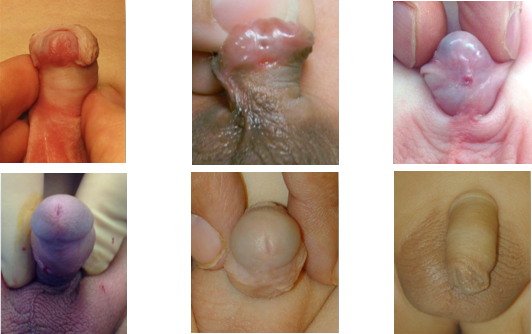
The most common way used around the world to fix distal hypospadias is the TIP repair, which is more commonly known as the “Snodgrass repair”. We have 95% success correcting distal hypospadias.
While many consider distal hypospadias repair a "minor" operation, recently published data shows that pediatric urologists have complications as high as 60% for distal hypospadias repairs. The average number of repairs done by pediatric urologists in the United States is only one a month, whereas we operate on hypospadias almost every day.
It is very important that the operation is done correctly the first time. If not, the risk of complications increases significantly. For this reason, distal hypospadias should never be considered a "minor" surgery.
Appearance after distal TIP repair, with circumcision (first 2 photographs) or foreskin repair (last picture). Note the normal shape and location of the urinary opening.
Hypospadias Discovered After Circumcision
One type of hypospadias occurs with a normal foreskin and so it is not discovered until after circumcision, or later in childhood when the foreskin retracts in boys who are not circumcised. This type of concealed hypospadias is often referred to as MIP, which stands for Megameatus with Intact Prepuce. Although circumcision is usually postponed until the time of hypospadias repair in boys with a partial foreskin, removal of the foreskin in those with concealed MIP hypospadias does not make repair of the urinary opening more difficult. It is important to emphasize these boys have a birth defect and not an injury during circumcision.

A boy with normal foreskin is found to have a concealed hypospadias when the foreskin is pulled back (A,B). When this is discovered at the time of newborn circumcision, the circumcision can be completed without making later hypospadias repair more difficult. If it is discovered in an uncircumcised boy when the foreskin becomes retractable, the hypospadias can be repaired along with a circumcision, or by saving the foreskin, whichever the family prefers.
The third picture (C) shows MIP hypospadias discovered after circumcision.
Severe Proximal Hypospadias
When the urinary opening is near or within the scrotum it is called “proximal” hypospadias. In these cases the penis is more likely to have downward bending to an extent that sexual activity may be difficult if it is not corrected. The scrotum often rides higher on the sides or even above the penis.
The degree of bending ("chordee") decides if 1 or more than 1 operation is best to correct proximal hypospadias. If there is minimal bending, the hypospadias is corrected in a single TIP (Snodgrass) repair. Those with more severe bending have a staged repair, the first to straighten the penis, and the second to make the urine channel. Although it is possible to correct severe hypospadias with "chordee" in a single stage, 2 operations give better results with fewer complications.
There is more than one type of staged repair. Major U.S. centers have recently reported complications in 50% to nearly 80% of patients with proximal hypospadias and chordee. Because of this, some pediatric urologists recommend partial repair, leaving the urine opening below the normal location, which looks abnormal and can result in urine spraying.
Dr. Snodgrass and Dr. Bush use a different repair that has much fewer complications and places the urine opening in the normal location at the tip of the penis. We recently published success reconstructing the most severe hypospadias in over 4/5 patients. Our goal for boys with proximal hypospadias is the same as those with distal hypospadias - a normal appearing and functioning penis.
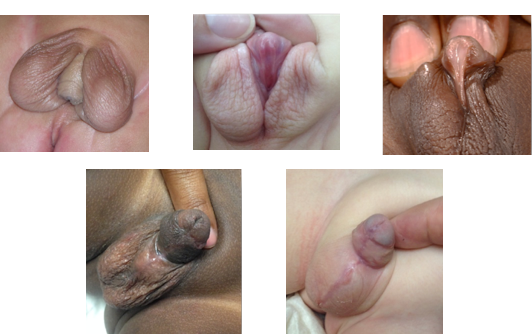
Examples of proximal hypospadias, also showing the scrotum higher than normal on the sides and above the penis (A, B, and C). Postoperative results of TIP (D) and staged graft repair (E), showing the normal appearance of the penis and urinary opening.
Testosterone Before Surgery
We do not recommend preoperative testosterone treatments. These have been used to grow the penis larger and to possibly increase blood flow to the skin. However, our studies have shown that results of surgery are not improved by testosterone. In fact, preoperative treatment with testosterone may increase complications and sometimes causes side effects such as aggressive behavior and pubic hair in infants and children.
Complications and Reoperations
There are several possible complications after hypospadias surgery. Unfortunately, additional surgery to correct these problems has an increased risk for more complications. For this reason, hypospadias reoperations should be done by experts with a large experience.
Fistulas (a leak below the urine opening) are the most common complication. We published 95% success repairing fistulas.
Other complications include blockages to the urinary channel (meatal stenosis or stricture depending on the exact location). Sometimes, the original hypospadias repair falls back open, called dehiscence. These problems require a redo hypospadias repair.

Examples of possible complications after hypospadias repair, including a fistula – an opening in the urinary channel (A), and glans dehiscence – where the urinary channel partially reopens (B, C).
Our goal for all these hypospadias reoperations is the same as with first-time surgeries – to make the penis straight, place the urinary opening in the correct position, and to make the penis look normal. We have achieved success even in patients who previously had up to 20 operations.
There may be problems with wound healing in patients who have had several hypospadias operations. In addition to surgery, Dr. Bush and Dr. Snodgrass use other innovative therapies specifically aimed at improving wound healing.
Some patients have been told they should not have any more surgery but instead learn to live with the problems they have. We can almost always correct these problems.
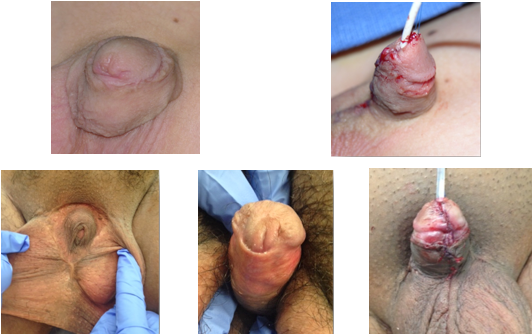
A TIP reoperation was done in this child who had a prior foreskin flap repair leaving the penis “tent” shaped (A). The flap was removed, giving the penis a more normal appearance (B).
A redo operation was needed for this patient whose penis was entrapped in scar tissue (A). The urinary opening was also not in the correct location because the head of the penis came back open after earlier surgery, a complication known as “glans dehiscence” (B).The arrows show the sides of the head of the penis that should be sewn together over the urinary channel. The immediate appearance after repair, with the penis freed from tethering scars and having the urinary opening at the tip, is shown in (C).
Hypospadias Repairs in Adults
Some men experience issues related to uncorrected hypospadias, such as having to sit to urinate because of urinary spraying or deflected stream, or embarrassment about the appearance. Other men we see had hypospadias surgery, but still have problems such as penile curvature/bending with erection, fistulas, urinary opening on the shaft of the penis, and hair or strictures within the urinary channel causing blockage.
It is commonly believed that hypospadias operations done in adults have more complications. Some adults have been told that surgery should not move the opening to the correct location on the head of the penis, but rather to leave it lower, which can result in difficulty aiming and spraying. A few have been advised to have no more surgery, but to live with their complications. This is not our experience at PARC Urology – as we’ve published. Our success rates in adults are as good as our high success rates in children.
Men with hypospadias fall “between the cracks” of urologic specialists. Most hypospadias operations are done by pediatric urologists who do not operate on adults. Adult reconstructive urologists specialize in urethral strictures, but usually do few hypospadias repairs. Dr. Snodgrass and Dr. Bush established PARC Urology in part to offer state-of-the-art hypospadias surgery to adults. We have one of the largest experiences in the world fixing adult hypospadias.

This gentleman had prior hypospadias repair that healed with his urinary opening on the shaft of the penis (A). The normal location of the urinary opening (at the tip of the penis) and normal shape of the head of the penis are demonstrated during (B) and after (C) hypospadias reoperation.
Post-operative Care
Care after hypospadias surgery is usually not difficult. Despite surgery on the penis, most boys have less discomfort than parents expect. Various medications including ibuprofen (Motrin or Advil) , acetaminophen (Tylenol), narcotics and bladder spasm medications are commonly used to help.
Many patients travel to PARC Urology for hypospadias surgery. Some ask about care for bandages and catheters, or what to do if problems occur when they return home. We provide detailed instructions for home care, no matter where you live. Problems requiring urgent attention are fortunately very uncommon after the types of hypospadias repairs done by Dr. Snodgrass and Dr. Bush. No matter where you live, you are only a phone call, email, or text message away.
Our detailed post-operative instructions are listed under "Patient Resources".
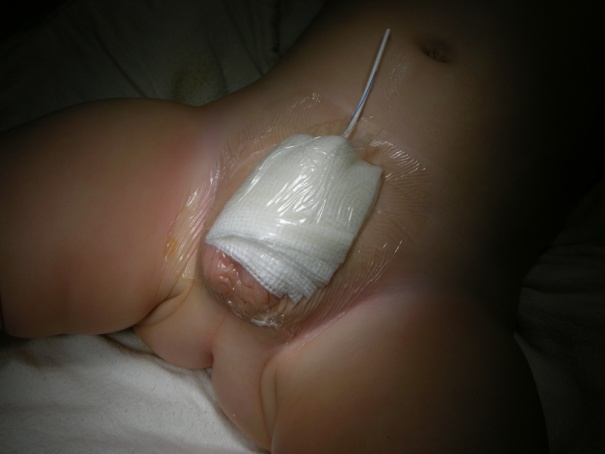
The bandages after TIP hypospadias repair consist of a clear plastic bandage over gauze (picture).
Teaching Hypospadias Repair Worldwide
As experts specializing in hypospadias surgery, Dr. Snodgrass and Dr. Bush are invited to many other countries to teach hypospadias repair. Their results are among the best in the world, and they have published more scientific articles on hypospadias than any other surgeons in history.
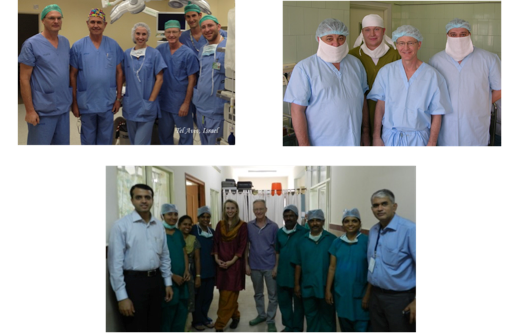
Dr. Bush and Dr. Snodgrass with surgeons in Israel (A), Russia (B), and India (C).
